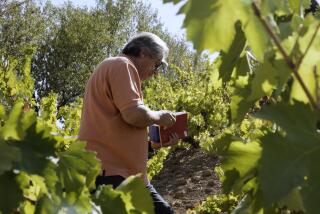Ancient winery found in Armenia
A UCLA-led team reported Monday that it had discovered a 6,000-year-old facility in an Armenian cave that contained everything necessary to produce wine from grapes, including a grape press, fermentation vats, storage jars, wine-soaked pottery shards and even a cup and drinking bowl.
The ancient winery is at least 1,000 years older than any similar installation previously known, and it was found in the same cave where researchers in June announced the discovery of the world’s oldest leather shoe.
The cave was abandoned when the roof caved in. All the organic material was preserved by a concrete-like layer of sheep dung that sealed everything in and prevented fungi from destroying the remains.
“Because of this unique preservation, we find all of these previously unknown but imagined organic materials” from the Copper Age, including grape seeds, withered grape vines and remains of pressed grapes, said archaeologist Gregory Areshian of UCLA’s Cotsen Institute of Archaeology, the co-leader of the expedition. Details of the find were described in the January issue of the Journal of Archaeological Science.
The wine press measured about 3 by 3 1/2 feet and was positioned to drain into a deep vat more than 2 feet deep. Similar to presses utilized as recently as the 19th century throughout Europe and in California, it was clearly meant to be used to smash the grape by foot. All around the top of the press, researchers found handfuls of grape seeds, remains of pressed grapes, grape must and desiccated vines. Botanists determined the species to be Vitis vinifera, the domesticated variety still used to make wine.
The vat would have held 14 to 15 gallons and was covered by a dark gray residue that contained the plant pigment malvidin, which gives wine its red color and stains clothing and carpets.
“The site is very important because it is so early and shows how advanced they already were,” said biomolecular archaeologist Patrick McGovern of the University of Pennsylvania, who was not involved in the research. “The fact that winemaking was already so well developed in 4000 BC suggests that the technology probably goes back much earlier.”
The cave is in a canyon where the Lesser Caucasus Mountains approach the northern end of the Zagros mountain range, near Armenia’s southern border with Iran. Researchers do not yet know the identity of the people who lived in the region, but they clearly carried out extensive trade. Pottery shards from the cave came from as far away as central Iran and southern Asia, and most of the stone implements were made of obsidian from a source that was at least three days away on foot, even though a flint source was much nearer.
The oldest previously known evidence of wine dates to about 5400 BC and was discovered at a site called Hajji Firuz in the northern Zagros mountains, where McGovern has found jars with traces of tartaric acid crystals, a chemical marker for wine. The oldest previous evidence of grape seeds and other organic materials dates to around 3150 BC and was found in the tomb of the Egyptian king Scorpion I. The oldest wine press is much younger, found in the West Bank and dating to about 1650 BC.
Areshian said the team originally thought the cave was a habitat, but excavation over the summer indicated that it was a burial site. They now believe that production of wine in the cave was solely for religious ceremonies associated with burials and with honoring the dead.
“This wine wasn’t used to unwind at the end of the day,” Areshian said. For that, they probably had separate winemaking facilities outside the cave.
The research was sponsored by UCLA and the National Geographic Society.
More to Read
Sign up for Essential California
The most important California stories and recommendations in your inbox every morning.
You may occasionally receive promotional content from the Los Angeles Times.










